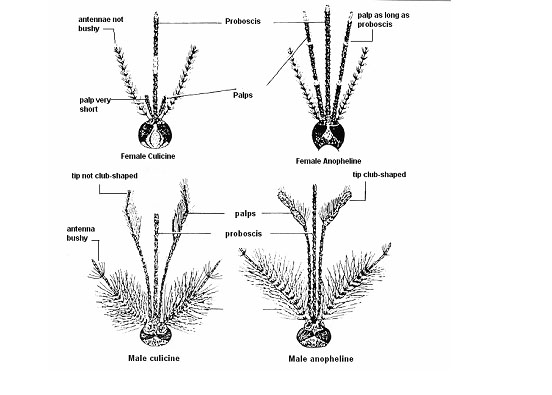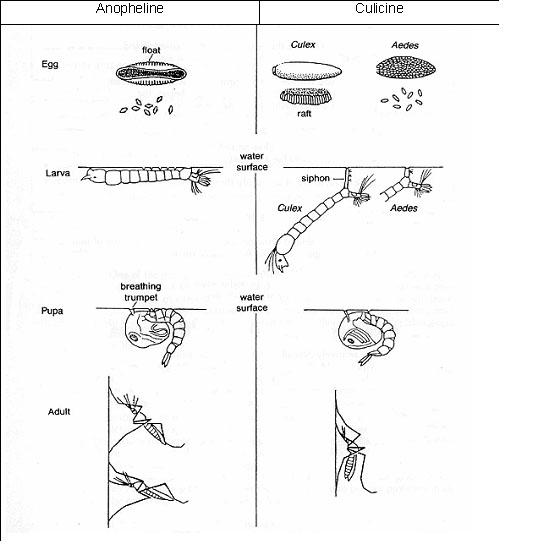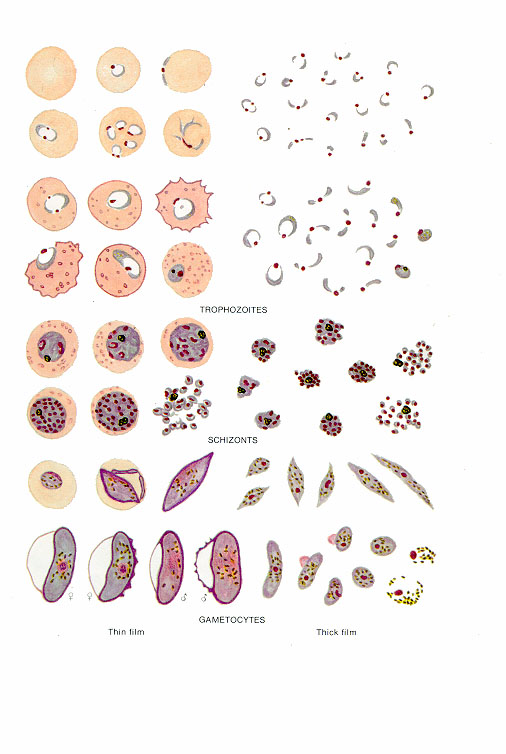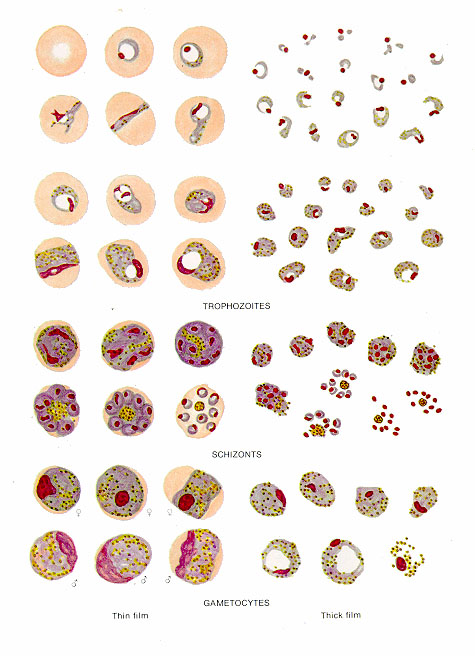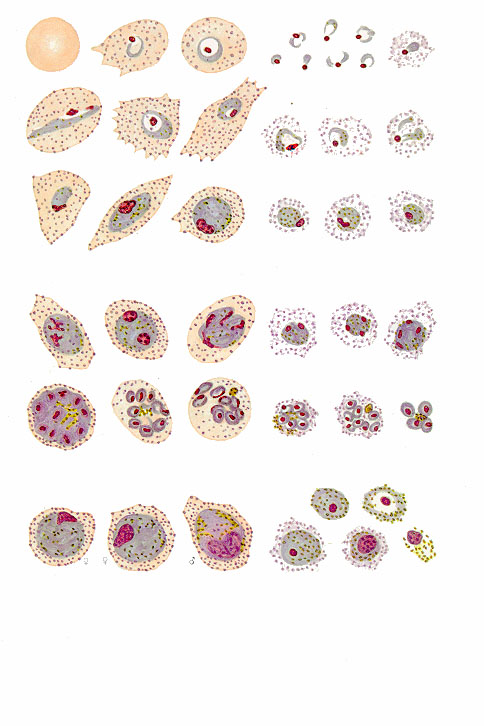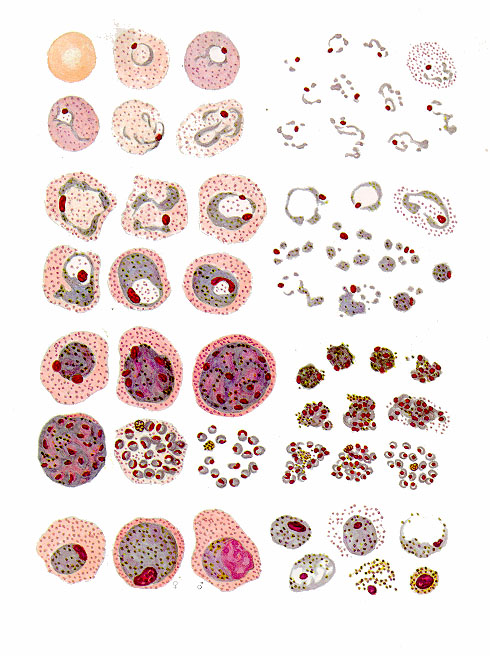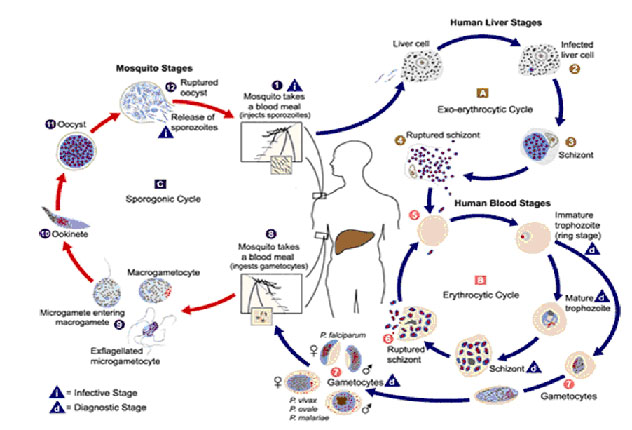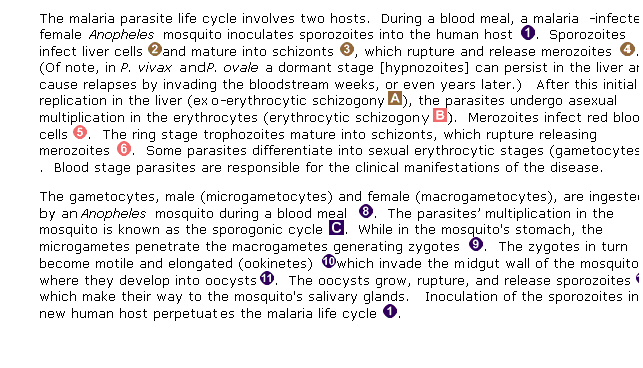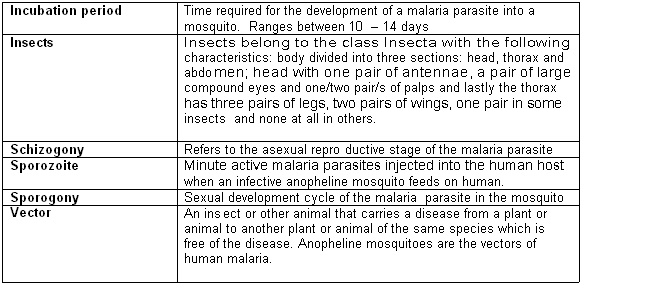Lesson 1:Introduction To Malaria
Contents
INTRODUCTION
<kaltura-widget kalturaid='292882' size='M' align='R'/> Welcome to Unit 1 of the Malaria course. We hope the introduction to this course has already familiarized you with the magnitude of the problem of malaria and why you need to become involved in malaria treatment, control and prevention activities.
Malaria is the most common disease in Africa. It is also the number one cause of death among young children and a significant cause of miscarriages among pregnant mothers. About 95% of children brought to health facilities with fever suffer from Malaria.
A significant amount of suffering, complications and death due to malaria can be prevented through prompt and correct treatment and prevention measures.
In this unit we shall discuss the importance of malaria, its definition, causative agents, transmission and life cycle of Malaria. We shall also briefly describe the presentation of the clinical course of malaria.
Please read each section thoroughly and do the learning activities as you go along. Take the adequate time necessary to do each activity. Incase you have difficulty completing any activity, study the section again or discuss the matter with your tutor.
We hope you will find this a good learning experience, enjoy your study.
|
By the end of this unit you should be able to:
|
|
As we begin our discussion, it is important for us to know what Malaria is and its importance? Definition: Malaria is a febrile disease caused by the blood parasite called Plasmodium transmitted by the bite of an infected female anopheles mosquito. |
Before you read on do the following activity. It should take you 10 minutes to complete.
1
………………………………………………………………………… ………………………………………………………………………… ………………………………………………………………………… ………………………………………………………………………… …………………………………………………………………………
………………………………………………………………………… ………………………………………………………………………… ………………………………………………………………………… ………………………………………………………………………… …………………………………………………………………………
……………………………………………………………………… ……………………………………………………………………… ……………………………………………………………………… ………………………………………………………………………
|
Now compare your answers with the following discussion.
• The public health importance of malaria
- Malaria is a serious public health problem in many parts of the world especially in sub-Saharan Africa where 90% of the illness occur. One-fifth of the world’s population is at risk of malaria. According to WHO there are between 300 – 400 million cases of malaria illness annually (WHO1). The greatest burden and most deaths occur among African children and are on the increase. It endangers the health of women and newborns. Malaria epidemics cause high morbidity and mortality in areas where they are prone particularly in the highland areas. There has been progressive spread of malaria into areas which had been free of the disease in the recent past. Malaria is therefore, an important disease requiring special attention.
• The public health impact of malaria
- The disease causes widespread premature death and suffering, imposes financial hardship on poor households, and holds back economic growth and improvements in living standards. The typical consequences of malaria are: acute febrile illness, chronic debilitation, complication of pregnancy, and impairment of the physical development and learning ability of children. These represent a huge negative social impact in the high burden areas (Holding & Snow, 2001).
Time lost and physical inability to engage in productive work and contribution to economic welfare translates directly into economic loss and impacts negatively in the quality of life of individuals, their dependence and or caretakers incase of children. Malaria dramatically inhibits economic growth by restricting individual worker productivity, tourism, foreign investment, and transportation (Gallup & Sachs, 1998). Furthermore, the macroeconomic toll is severe, particularly in sub-Saharan Africa, since malaria may cost more than one percentage point of economic growth every year (Sachs & Maloney, 2002). The social and economic toll imposes substantial costs to individuals and governments. Costs to individuals and their families include: purchase of drugs for treating malaria at home; expenses for travel to, and from health clinics; lost days of work; absence from school; expenses for preventive measures; expenses for burial incase of death and other incidental expenditures. Costs to governments include: maintenance of health facilities; purchase of drugs and supplies; public health interventions against malaria, such as insecticide-treated nets; lost days of work with resulting loss of earning; and lost opportunities for joint economic ventures. Such costs can add substantially to the economic burden of malaria particularly in endemic countries and strongly impedes their economic growth.
1.2 Malaria vectors and their characteristics
Malaria is a vector borne disease. The vector involved is a female anopheles Mosquito with distinct characteristics that differentiate them from other types of mosquitoes. O There are many species of anopheles mosquitoes but only certain species can transmit the parasite. Examples of Anopheles species that cause malaria are An. gambiae sl and An. funestus. Different species of Anopheles mosquitoes transmit malaria in different parts of the World.
- Entomology work is important in malaria control activities. Some of the tasks which are undertaken in entomology include entomological surveys, identification of adult female anopheline mosquitoes and mapping of the high risk areas.
During entomology activities one comes across many insects and so it is important to know how to identify mosquitoes. Next we shall look at how to differentiate between mosquitoes and other insects.
How well can you differentiate an Anopheles mosquito from other Mosquitoes? Find out by doing the following activity.
Well done! We hope that your list included the following features which help us to identify adult mosquitoes. These are
- Long and segmented antennae;
- A long proboscis (the adapted mouth parts), which projects forward and which the female uses to pierce the skin when taking a blood meal;
- A body and wings covered with scales; and
- Wings with veins which show a definite pattern
There are over 2,600 known species of mosquitoes in the world. However, in Africa we are mainly concerned with two species namely, the An gambiae sl and An funestus. The life cycle of a mosquito has four distinct stages of development, egg, larvae, pupa and adult. The eggs, larvae and pupae stages are aquatic but the emerging adults are free-flying insects. Mating usually takes place immediately after the adults emerge from the pupa before females seek a blood meal. Both females and males suck nectar and other plant juices as energy sources; but females require a blood meal for maturation of eggs. Mosquitoes rest either indoor or outdoor during the day in cool humid locations to minimize moisture loss. Their biting activities take place from dusk, through out the night until just before dawn, feeding either indoor or outdoor. Mosquitoes have preference for various hosts (Human & animal) for their blood meal; however, efficient malaria vectors have preference for human blood.
How do we differentiate between an anopheline mosquito and a culicine? Please carry out the following activity.
Confirm your answer as you read the following discussion.
One way that anopheline mosquitoes can be distinguished from culicines is by the length and shape of the palps, see Figure 2 below.
Females
- Female anophelines have palps as long as the proboscis
- Female culicines have palps which are much shorter than the proboscis
Males
- Anophelines have palps longer than proboscis and are club-shaped at tip
- Culicine have palps longer than proboscis, with tapered tips.
- Figure 2: Some distinguishing features of Anopheline and Culicine mosquitoes
Another way of distinguishing anopheline and culicine mosquitoes is by observing the following:
Culex eggs clump together forming a “raft”. Aedes eggs float singly, Anopheles eggs have floats.
The anopheles larvae rest parallel to the water surface, breathing with specialized hair at last segment. This is in contrast with culicine larvae which rest at an angle to the water surface and has a long siphon for breathing. The pupae for both species are active and do not feed.
The adult anopheles rests at an angle while culicine rests parallel to the resting surface respectively. Figure 3 illustrates these differences.
- Figure 3: Life cycle of anopheline and culicine mosquitoes
The Different Species of Malaria Causing Parasite
It was once thought that malaria came from fetid marshes, hence the name mal aria, (bad air). However, in 1880 scientists discovered the real cause of malaria was a one-cell haemo (blood) parasite or protozoa called Plasmodium. There are four species of Plasmodium that infect humans.
Before you read on, do Activity 4 below. It should take you 10 minutes to complete.
| 4
List down the four (4) species of Plasmodium i)………………………………………………………………………… ii)…………………………………………………………………………… iii)………………………………………………………………………… iv)……………………………………………………………………………
ii)……………………………………………………………………………… iii)…………………………………………………………………………… iv)………………………………………………………………………………
|
Compare your answer with the following discussion.
The four species of Plasmodium which are known to cause disease in man are:
Plasmodium vivax (Tertian).
:It is the most common species in the World. It is the largest of the malaria parasites found in humans. The length of its asexual cycle is 48 hours. Relapses are common in vivax malaria due to emergence of new blood forms from maturing secondary liver schizonts. In tropical areas, relapses may arise within three to four months of primary attack, while in subtropical areas relapses occur only after nine months or more.
Plasmodium ovale, (Tertian)
- It is a relatively a rare species with a frequency of less than 5%. It may sometimes be confused with P. vivax. The length of its asexual cycle is 48 hours. Relapses occur as in P. vivax but the disease tends to be more chronic.
Plasmodium malariae. (Quartan)
- It is a less common species whose length of its asexual cycle is 72 hours. P. malariae is associated with quartan malaria.
Plasmodium falciparum, (Sub-Tertian)
- It is the commonest species in Africa and it accounts for 95 - 98% of all malaria infections.. It is responsible for severe illness cerebral malaria and other complications and may cause death. The length of asexual cycle is about 48 hours. Fever is produced when the schizonts are mature i.e. at 48 hours interval. Sub-tertian means that diurnal periodicity is common. The liver stage of development take about 14 days.
In our environment, you may have noticed that many malaria laboratory tests report the presence of P. falciparum. This is because it is the most common cause of malaria in our environment. Indeed in Africa, Plasmodium falciparum is the most common type of malaria parasite transmitted in Africa, south of the Sahara, accounting in large part for the extremely high mortality in this region. Figure 4 below illustrates the differences between the various species of the malaria parasite.
Plate 1 Appearance of Plasmodium falciparum stages in Giemsa stained thin and thick blood films
- Plate 2 Appearance of plasmodium malariae stages in Giemsa stained thin
and thick blood films
- Plate 3 Appearance of plasmodium ovale stages in Giemsa stained thin and
thick blood films.
- Plate 4 Appearance of plasmodium vivax stages in Giemsa stained thin and
thick blood films.
THIN ---- THICK
Plates courtesy of: Malaria Parasitological Diagnosis: WHO 1991
Mode of Transmission of Malaria:
Having read about the definition and the causative species of Malaria, let’s turn to the mode of transmission of Malaria.
Before you read on, here is an activity to enhance your learning process, take about 10 minutes to think about it and write out your answer.
| 5
How is Malaria transmitted? Name the vector involved in the transmission. ……………………………………………………………………………………… ……………………………………………………………………………………… ……………………………………………………………………………………… ……………………………………………………………………………………… ……………………………………………………………………………………… ……………………………………………………………………………………… ……………………………………………………………………………………… ………………………………………………………………………………………
|
As we mentioned earlier, malaria is transmitted by the female Anopheles mosquito which requires blood for the development of its eggs. These eggs are laid on stagnant water or slow flowing water where they stay for 2-3 days before they hatch to release mosquito larvae. The larvae grow beneath the water surface and become pupa. After a few days the pupa develops into adult mosquitoes and flies away.
The development of mosquitoes from egg to larvae to adults takes 7-14 days at a temperature of 31oC or 20 days at 20oC. If the adult mosquito is female, it looks for a blood meal to facilitate egg development, thereby starting the development cycle all over again. If the adult mosquito is male it feeds on plant juices.
When a mosquito sucks the blood of a person who has malaria parasites in his or her blood, the mosquito picks male and female gametocytes where they undergo a series of changes to become sporozoites. The sporozoites are the infective stages of malaria parasites in the mosquito. This process called sporogonic cycle takes about 10 -14 days depending on environmental temperature. When a mosquito carrying sporozoites bites a person, it passes the parasites into the blood of that person, thereby infecting that person with malaria.
{• In summary, the transmission of Malaria depends on interaction of the following factors: o Presence of the infective vector o Susceptible human host o Suitable environment for complete sporogonic cycle e.g Pf ceases to develop below 200 C while Pv ceases at 160C}
The Malaria Life Cycle
Now that you know the mode of transmission of malaria, it is important for you to also understand the malaria cycle. You have already come across some aspects of the cycle when dealing with the mode of transmission. Before you proceed, attempt the following activity.
| 6
In the space provided below and in your own words; describe the life cycle of the Malaria parasite. …………………………………………………………………………… …………………………………………………………………………… …………………………………………………………………………… …………………………………………………………………………… …………………………………………………………………………… …………………………………………………………………………… …………………………………………………………………………… …………………………………………………………………………… …………………………………………………………………………… ……………………………………………………………………………
|
Now read the following discussion and compare your answer with the information given.
The Malaria parasite lifecycle begins when an infected adult female Anopheles mosquito bites a human being to feed on his or her blood. As it feeds on this blood, it releases malaria sporozoites (parasites) into the blood stream of the host (human being). This is the infective bite.
Once the parasites enter the human blood stream they move quickly to the liver cells where they develop and multiply (schizogony). The infected liver cells rapture and release numerous merozoites into the blood, which invade red blood cells (RBCs). This stage takes 9-14 days. Within the RBCs the parasites develop from “rings” into blood schizonts. The schizonts then rupture the RBCs releasing numerous merozoites which invade new RBCs. When the infected red blood cells rapture, this process initiates the chills and fever which are characteristic of Malaria. Indeed, the peaks of fever experienced during malaria coincide with the release into blood circulation of malaria parasites (merozoites) from raptured RBCs.
The period between the infective bite and the onset of symptoms (i.e fever, chills etc,) is called the incubation period of malaria. As we mentioned earlier, the incubation period is usually 7-14 days but may be shorter as in P. falciparum or longer in the case of P. vivax and P. malariae. See figure 5 for an illustration of the cycle of malaria.
Figure 5 Life Cycle of human malaria parasite Illustration courtesy of CDC
Illustration courtesy of CDC
Next, let us look at how we classify the clinical cause of malaria.
Clinical Classification of Malaria
The clinical course of malaria infection may be classified into two stages:
- uncomplicated or mild disease
- severe and complicated
Compare your answers as you read the following discussion on the two stages.
Uncomplicated Malaria:
It presents with fever, chills, nausea, vomiting, headache, joint pains, general malaise, and profuse sweating.
It is important to promptly diagnose and treat uncomplicated malaria for two reasons:
- To avoid the disease progressing to a severe and complicated situation
- To reduce the number of parasite carriers within the community and hence interrupt further transmission
Severe Malaria:
This is a form of life threatening malaria that can affect many systems of the body as shown in the following table.
Table 1 Effects of malaria on different systems of the body
- Malaria complications are life threatening so we should stop the clinical stage from progressing by early diagnosis and administration of the correct treatment.
Conclusion:
You have now come to the end of this unit. In this unit, we defined malaria, discussed its causative organism, its life cycle and mode of transmission. We also considered the classification of the clinical course of malaria.
You should now review the learning objectives at the beginning of this unit to see if you have achieved all of them. If you have achieved them do the attached assignments and send it to us for marking. If you have any problems in understanding any of the sections, do not hesitate to consult your tutor about it. In the next unit we shall discuss the clinical assessment of malaria.
Glossary
References
- WHO (1999), Roll Back Malaria: Increasing the momentum.
- WHO (1992), Entomological field technique for malaria control. Learner’s.
Russell Paul, West L. and Manwell R. (1946), Practical Malariology, WB Saunders Company.
|
DIRECTORATE OF LEARNING SYSTEMS
Student Name: __________________________________ Student Identification Number:_______________________ Student Postal Address: __________________________ __________________________ MALARIA COURSE
Instructions: Answer all the questions in this assignment. When you complete them all mail the assignment or bring it in person to AMREF. 1.Outline the importance of Malaria …………………………………………………………………………… …………………………………………………………………………… …………………………………………………………………………… …………………………………………………………………………… …………………………………………………………………………… …………………………………………………………………………… …………………………………………………………………………… …………………………………………………………………………… …………………………………………………………………………… 2.Outline the impact of malaria …………………………………………………………………………… …………………………………………………………………………… …………………………………………………………………………… …………………………………………………………………………… …………………………………………………………………………… …………………………………………………………………………… …………………………………………………………………………… …………………………………………………………………………… …………………………………………………………………………… 3.List down the external characteristics of an adult mosquito …………………………………………………………………………… …………………………………………………………………………… …………………………………………………………………………… …………………………………………………………………………… …………………………………………………………………………… …………………………………………………………………………… …………………………………………………………………………… …………………………………………………………………………… …………………………………………………………………………… 4.List down the features used in differentiating between the life stages of the anopheline and culicine mosquitoes …………………………………………………………………………… …………………………………………………………………………… …………………………………………………………………………… …………………………………………………………………………… …………………………………………………………………………… …………………………………………………………………………… …………………………………………………………………………… …………………………………………………………………………… …………………………………………………………………………… 5. Outline the mode of transmission of Malaria. …………………………………………………………………………… …………………………………………………………………………… …………………………………………………………………………… …………………………………………………………………………… …………………………………………………………………………… …………………………………………………………………………… …………………………………………………………………………… …………………………………………………………………………… …………………………………………………………………………… 6. Describe the life cycle of the malaria parasite. …………………………………………………………………………… …………………………………………………………………………… …………………………………………………………………………… …………………………………………………………………………… …………………………………………………………………………… …………………………………………………………………………… …………………………………………………………………………… …………………………………………………………………………… …………………………………………………………………………… 7. In your opinion, why do you think malaria has become a disease of significance in the your country? …………………………………………………………………………… …………………………………………………………………………… …………………………………………………………………………… …………………………………………………………………………… …………………………………………………………………………… …………………………………………………………………………… …………………………………………………………………………… …………………………………………………………………………… …………………………………………………………………………… 5. What factors influence malaria transmission in your environment? …………………………………………………………………………… …………………………………………………………………………… …………………………………………………………………………… …………………………………………………………………………… …………………………………………………………………………… …………………………………………………………………………… …………………………………………………………………………… …………………………………………………………………………… …………………………………………………………………………… Congratulations! You have come to the end of this assignment. Before you send it to AMREF, remember to check if you have written your correct address and student number. Time spent doing the assignment: Hours …………………. Minutes ………….. |
Enjoy the rest of the course!

